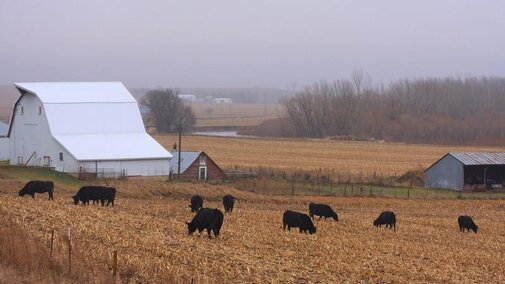Winter Grazing Pastures
Grazing stockpiled winter range or pastures has several benefits. It is much less costly compared to feeding hay. On native range, there is little risk of damage to the grasses because they are dormant and winter stocking rates can be somewhat higher compared to the summer. Oftentimes, you will notice that native pastures only grazed during the winter are the most vigorous and productive.
It is important, though, that you closely monitor body condition of the cows during the winter grazing period. Crude protein is generally the most limiting nutrient during winter grazing. The crude protein content of dormant warm-season grasses will be around 5-7% and will slowly decline through the winter months from weathering and as the cattle selectively grazing the higher quality forage in a pasture.
Stockpiled cool-season grass pastures are those that have been only lightly or not grazed during the growing season. These pastures may have slightly higher crude protein levels, but that quality will also decline as the winter progresses. Feeding the right amount of protein supplement while winter grazing will allow the cows to effectively utilize that winter forage and maintain the desired body condition.
A possible grazing management strategy that can be used is to do simple rotational grazing where cattle are periodically moved to a new winter pasture. This will allow for a more consistent diet quality when winter grazing.
Whatever your strategy, consider carefully what kind of nutrition animals are getting from the pasture so you neither underfeed nor overfeed expensive supplements. And be sure to provide salt, calcium, phosphorus and vitamin A free choice at all times.
Winter grazing is a great opportunity to reduce winter feed costs. With proper management, it can help you meet many of your feeding goals.
Fall Fertilization on Cornstalks Before Grazing
By Brad Schick
Grid sampling and application of dry fertilizer is common in the fall, but is it safe to graze corn residue fields that have had the fertilizer applied?
The answer comes down to how much risk in animal wellbeing we are willing to take. The risk potential varies based on different fertilizer components. Potassium, zinc, nitrogen and sulfur nutrients could all be toxic, but risk depends on consumption rate and the amount animals can physically consume. To reduce risk, wait to graze until after precipitation, whether that be rain or snowmelt. Waiting for rain is more important if the application stuck to damp or wet residue.
Calculations can tell if what was applied would pose a risk.
Nitrogen fertilizers can cause toxicity in different ways related to amounts, but any spill available for consumption is a high risk. There are other fertilizer components in a grid-sampled application that may or may not be a problem due to how much is in the mix. For example, potassium would be toxic at 30,000 mg/kg of intake or 3% of the diet, which is very unlikely. High potassium intake can cause a magnesium deficiency, so making a high magnesium mineral available might be considered. High sulfur intake could cause polioencephalomalacia or PEM, but that is also unlikely. A lot of downed corn could also increase the risk of PEM. Cattle can tolerate 0.5% sulfur in the diet, but corn residue only contains close to 0.1%. Zinc consumption is fine up to 1000 mg/kg without problems and phosphorus can be tolerated up to 1% of the diet.
To review: The safest approach for grazing cornstalks is to wait until after a rain or graze before fertilizer application, but that may not be realistic. Assessing the fertilizer amount will give a good idea of risk level. If the fertilizer can easily be seen on the residue, be more cautious when grazing.

